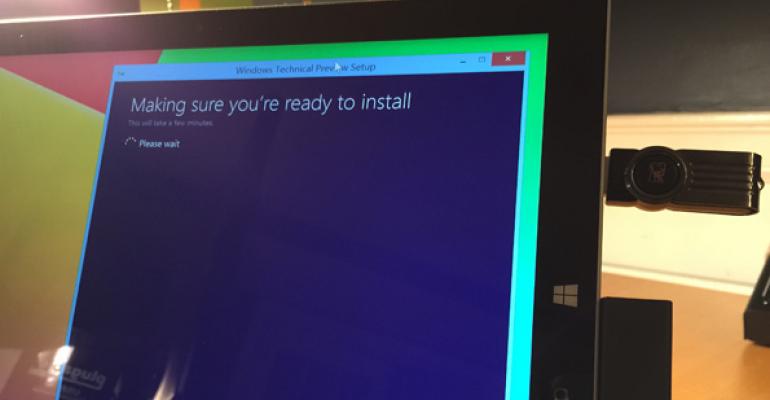Exactly 20 years ago, I received my first beta version of Windows from Microsoft (Windows 4.0, which became Windows 95). And boy have things changed over that time. Microsoft moved from floppies to CDs to DVDs to ISOs and digital delivery, and the size, complexity and functionality of Windows has ballooned to match. But if there's one thing that hasn't changed in the slightest—for me, at least—it's the excitement I feel at the start of a new beta. It's time to mess up my PCs. And I couldn't be happier.
I missed the start of the festivities this morning because I was flying home from San Francisco and yesterday's Windows 10 briefing. No worries: I called my wife and instructed her to download the Windows Technical Preview so that the various ISOs—Microsoft has released both Enterprise and non-Enterprise versions of the build in both x86 (32-bit) and x64 (64-bit) forms—would be ready for me when I arrived home. Which they were.
The Windows Technical Preview represents a very early and incomplete look at Windows 10. But I don't care. I'm going to slap this thing on as many PCs as I can—and I have a ton of PCs—and see how it reacts in different configurations. I'm particularly interested in the differences between tablets and traditional PCs, though I know this stuff will improve over time.
The first step, of course, is to sign up for the Windows Insider Program at preview.windows.com. This just requires you to sign in with your Microsoft account (MSA), click a Get Started button, and then agree to an end-user license agreement. No surprises here. (Or, if you want the Enterprise version, head on over to the Windows 10 web site on TechNet instead. I'll look at the differences between Enterprise and non-Enterprise soon.)
Be sure to bookmark the Windows Technical Preview download page. I've found that the site no longer provides links for downloading if you've downloaded it once, which I assume is a mistake. What you're getting is a 3-4 GB ISO file, which you can use directly to install into a VM or turn into a Setup disc or USB media by using the Windows 7 USB/DVD Download Tool. (Time for a rename there, Microsoft.) If you've been doing the beta thing for a while, no surprises so far.
From an install perspective, the Windows Technical Preview is kind of old school and looks and works just like the Windows 8.x Setup routine, so it's pretty clear that no or little work was done in that area yet. But that sort of underlines the vibe I've had all along that—despite Microsoft protestations to the contrary—Windows 10 is really just Windows 8.2 from a PC/tablet user experience perspective. Which is great, since Windows 8.1 only needs a few tweaks to put it over the top anyway.

Microsoft says that you should update your PC completely via Windows Update before attempting to upgrade. That's obviously good advice, so be sure to do that. You could also install Windows Technical Preview in a clean install scenario and/or in a virtual machine. I'll do both, of course, in addition to upgrading Windows 7- and Windows 8-based PCs. But first things first.
Microsoft provides a product key, but Setup didn't ask for it. It's NKJFK-GPHP7-G8C3J-P6JXR-HQRJR for the non-Enterprise version that most people will install. (And PBHCJ-Q2NYD-2PX34-T2TD6-233PK for the Enterprise version.) You never know.
Because Windows 7 and Windows 8 are fully supported upgrades, you will be asked to choose what you wish to keep if you do an upgrade. Most will wish to keep settings, personal files and apps, which is the full meal deal, but you could choose "nothing" if you wish to start over from scratch. Just be sure to deauthorize iTunes or any other application that requires such a check, and make sure everything is backed up (or better yet, just stored) to the cloud (OneDrive, whatever) before diving in.
I've got a variety of machines installing the preview as I write this. So I'll be back soon with more.





